Tarantulas are intriguing creatures that lead fascinating lives underground. Their burrowing habits and behaviors have captivated the curiosity of many enthusiasts. In this comprehensive guide, we will delve into the world of burrowing tarantulas, exploring the species that dig and create intricate underground homes. Join us as we uncover the hidden lives of these remarkable arachnids and gain insights into their unique habitat requirements.
Key Takeaways:
- Several tarantula species exhibit burrowing tendencies and create intricate underground habitats.
- Choosing the right enclosure is crucial to provide a suitable environment for a burrowing tarantula.
- The substrate selection plays a vital role in mimicking the tarantula’s natural habitat and promoting burrowing behavior.
- Maintaining appropriate temperature and humidity levels is essential for the health and well-being of a burrowing tarantula.
- Providing hiding areas and climbing structures enhances the tarantula’s habitat, promoting natural behaviors.
Which Tarantulas Burrow
Choosing the Right Enclosure
When it comes to creating the perfect habitat for your burrowing tarantula, choosing the right enclosure is of utmost importance. Providing an appropriate living space will ensure the comfort and well-being of your tarantula. Here are some key factors to consider: which tarantulas burrow
- Size: The size of the enclosure should allow for the tarantula’s natural burrowing behavior. A spacious enclosure will provide ample room for the tarantula to dig and create its underground home. It’s important to strike a balance—too small of an enclosure can restrict the tarantula’s movement, while too large of an enclosure can make it difficult for the tarantula to find its prey.
- Location: Place the enclosure in a quiet area of your home that is away from high traffic or loud noises. Tarantulas are sensitive creatures, and excessive stress can negatively impact their health. Creating a calm and peaceful environment will help your tarantula thrive.
- Lid: Choose an enclosure with a secure lid to prevent the tarantula from escaping. Tarantulas are skilled climbers and can escape from poorly designed enclosures. A tight-fitting lid will ensure the safety of your pet.
By carefully considering these factors, you can select an enclosure that meets the needs of your burrowing tarantula and provides a comfortable and secure environment for it to thrive. tarantulas that dig
Table: Comparison of Tarantula Enclosure Options
| Enclosure Type | Pros | Cons |
|---|---|---|
| Glass Terrarium |
|
|
| Plastic Container |
|
|
| Acrylic Enclosure |
|
|
Table: Comparison of Tarantula Enclosure Options
When choosing the right enclosure for your burrowing tarantula, it’s important to consider the pros and cons of different enclosure types. The table above provides a helpful comparison, highlighting the key features of glass terrariums, plastic containers, and acrylic enclosures. Consider your own preferences, budget, and the specific needs of your tarantula when making your decision. tarantulas that create burrows
Tarantula Substrate Selection
Choosing the right substrate is crucial when creating a suitable habitat for your burrowing tarantula. The substrate not only provides a comfortable surface for the tarantula to burrow into but also plays a significant role in maintaining proper humidity levels. One highly recommended substrate for burrowing tarantulas is coconut coir. It is a soft and absorbent material that closely mimics the tarantula’s natural environment, allowing them to exhibit their natural burrowing behavior.
In addition to coconut coir, incorporating rocks into the enclosure can enhance the tarantula’s habitat. Rocks provide climbing opportunities and create a more aesthetically pleasing environment. It is important to choose rocks that are smooth and have no sharp edges to ensure the safety of your tarantula. tarantula burrowing habits
When selecting substrate and rocks for your tarantula’s habitat, it is essential to avoid materials that may contain harmful chemicals or substances. Always opt for natural and untreated materials to ensure the well-being of your tarantula.
Table: Comparison of Different Substrates for Burrowing Tarantulas
| Substrate Type | Advantages | Disadvantages |
|---|---|---|
| Coconut Coir | – Soft and absorbent | – May require rehydration |
| Peat Moss | – Retains moisture well | – May harbor mold |
| Topsoil | – Provides a natural look | – Can be easily compacted |
| Vermiculite | – Good moisture retention | – Can be dusty if not hydrated |
Table: Comparison of different substrates for burrowing tarantulas.
Temperature and Humidity
Maintaining the correct temperature and humidity levels is crucial for the well-being of a burrowing tarantula. These factors play a vital role in creating a comfortable and healthy environment for your pet.
For temperature regulation, it is recommended to maintain a range between 70°F and 85°F (21°C to 29°C). This can be achieved by using various heating methods such as under-tank heating pads or ceramic heat emitters. It is important to monitor the temperature levels using a thermometer to ensure it remains within the optimal range and does not exceed the upper limit, which can be detrimental to the tarantula’s health. burrowing behavior of tarantulas
Humidity is equally important for tarantulas, as it helps replicate their natural habitat. The ideal humidity range for most species is around 60% to 80%. This can be achieved by misting the enclosure with water daily or using a humidifier. It is crucial to avoid excessive humidity, as it can lead to mold growth and respiratory issues for your tarantula. Using a hygrometer to monitor humidity levels and make necessary adjustments is advisable.
| Temperature | Humidity |
|---|---|
| 70°F – 85°F (21°C – 29°C) | 60% – 80% |
By maintaining the appropriate temperature and humidity levels, you can create a comfortable and thriving habitat for your burrowing tarantula. Remember to regularly monitor and make necessary adjustments to ensure the well-being of your pet.
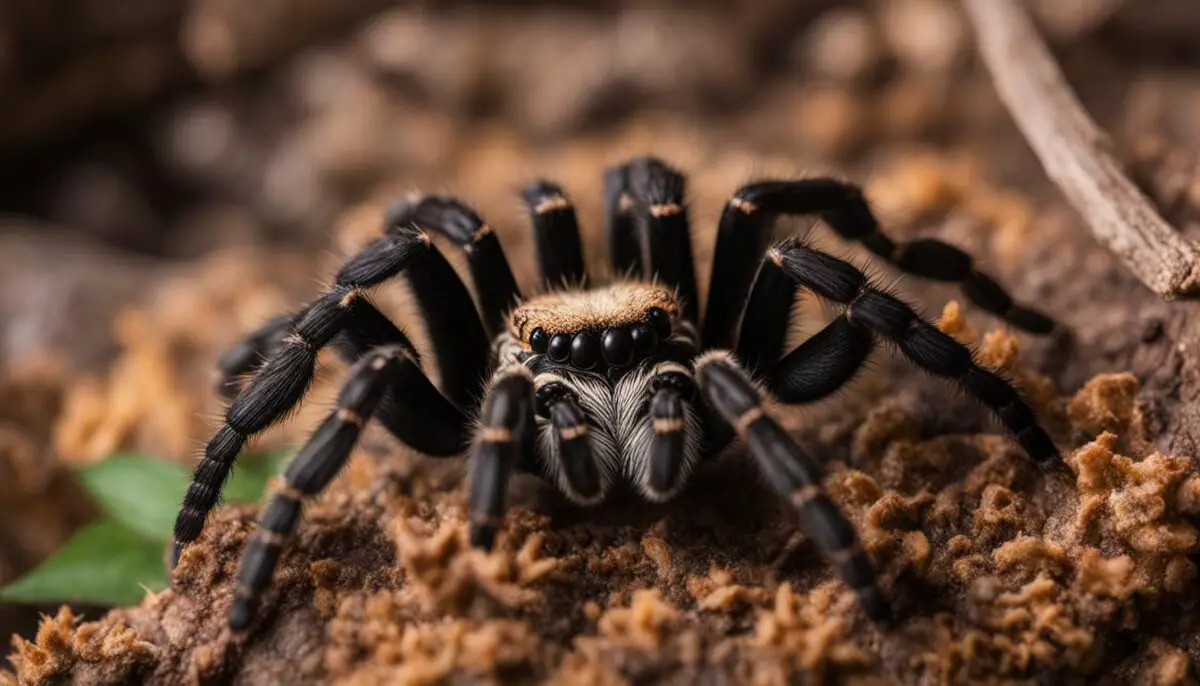
Furnishing the Enclosure
Enhancing a burrowing tarantula’s habitat with appropriate furnishings is important for their enrichment and natural behavior. There are several key elements you can add to your tarantula’s enclosure to create a comfortable and stimulating environment. underground lives of tarantulas
Hiding Areas
Tarantulas are naturally shy creatures and will appreciate having hideaways in their enclosure. Flower pots or reptile caves can provide excellent hiding spots where your tarantula can retreat to when feeling stressed or threatened. Make sure to choose hiding areas that are spacious enough for your tarantula to comfortably fit in. tarantula species with burrowing tendencies
Climbing Structures
While burrowing tarantulas spend most of their time underground, they also have a natural inclination to climb. Adding climbing structures, such as branches or vines, can provide your tarantula with opportunities for vertical movement and exercise. Just make sure that the climbing structures are securely positioned to prevent any accidental falls or injuries.
Substrate Enrichment
Another way to enhance your tarantula’s enclosure is by adding substrate enrichments. These can include leaf litter, pieces of bark, or even fake plants. These additions mimic the natural environment and provide opportunities for your tarantula to engage in natural behaviors such as web-building or creating burrows. Additionally, it adds visual interest to the enclosure and creates a more aesthetically pleasing habitat. tarantulas and their underground habitats
Creating a furnished and enriched enclosure for your burrowing tarantula will not only benefit their physical well-being but also provide them with a stimulating and engaging environment. Remember to choose hiding areas, provide climbing structures, and consider substrate enrichments to mimic their natural habitat. By providing these essential furnishings, you can help create an optimal living space where your tarantula can thrive and exhibit their natural behaviors.
Feeding and Water
Feeding and providing water for your burrowing tarantula is essential for its overall health and well-being. Tarantulas are carnivorous creatures and require a diet of live insects to thrive. Some suitable food options for tarantulas include crickets, grasshoppers, mealworms, and roaches. These insects should be gut loaded with nutritious foods before being offered to the tarantula. It is also recommended to dust the prey with calcium and vitamin D supplements to ensure your tarantula receives all the necessary nutrients.
When feeding your tarantula, it is important to observe its behavior and appetite. Avoid overfeeding as this can lead to obesity and other health issues. A general rule of thumb is to offer prey that is approximately the same size as the tarantula’s abdomen. If the tarantula is not consuming its prey, remove it after a few hours to avoid potential stress or contamination of the enclosure.
Providing access to fresh water is crucial for tarantulas. A shallow dish filled with clean, chlorine-free water should be available at all times. It is important to regularly check and replenish the water to ensure your tarantula stays hydrated. Avoid overflow or flooding of the enclosure, as excessive moisture can cause mold and other harmful conditions.
Feeding Schedule
To maintain a healthy feeding routine for your tarantula, it is recommended to feed adult tarantulas once every one to two weeks. Spiderlings and juveniles may require more frequent feedings, ranging from two to four times a week, depending on their size and growth rate. Keep in mind that each tarantula species may have specific feeding requirements, so it is important to research the dietary needs of your particular species for optimal care.
| Tarantula Species | Feeding Frequency |
|---|---|
| Aphonopelma chalcodes | 1-2 times per week |
| Grammostola rosea | 1-2 times per month |
| Brachypelma smithi | 1-2 times per month |
“Feeding and providing water for your tarantula is essential for its growth and overall well-being. By offering a varied diet of live insects and ensuring a constant supply of fresh water, you can ensure that your tarantula is healthy and thriving. Remember to observe your tarantula’s feeding behavior and adjust the feeding schedule accordingly. Proper nutrition and hydration are key to maintaining a happy and healthy burrowing tarantula.”
Overall, proper feeding and water requirements are vital aspects of tarantula care. By providing a balanced diet and access to fresh water, you can support your tarantula’s growth and overall health. Remember to research the specific dietary needs of your tarantula species and adjust the feeding schedule accordingly. With proper care, your burrowing tarantula will thrive in its underground habitat.
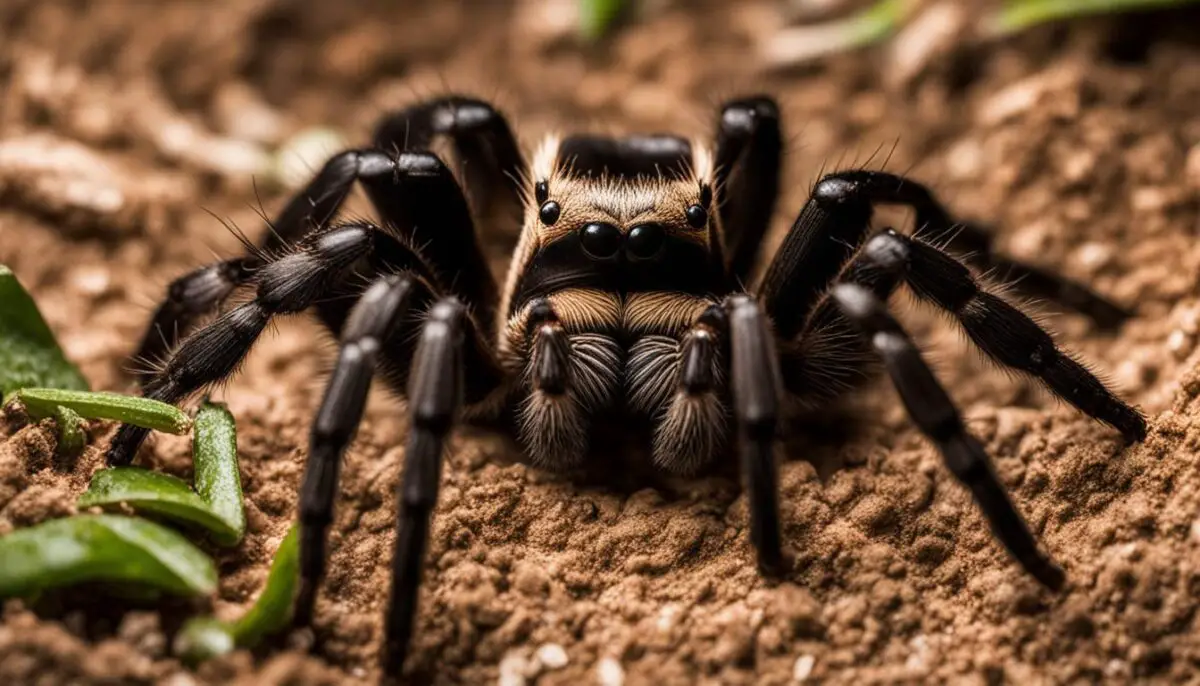
Cleaning and Maintenance
Regular cleaning and maintenance are essential for maintaining a hygienic and safe habitat for your burrowing tarantula. By following these simple steps, you can ensure the health and well-being of your pet:
Spot Cleaning
Perform daily spot cleaning to remove any feces or uneaten food from the enclosure. This will prevent the buildup of bacteria and keep the habitat clean for your tarantula.
Substrate Replacement
Every few months, it is important to replace the substrate in the enclosure. This helps maintain cleanliness and prevents any odor or mold from developing. Remove the old substrate and replace it with fresh, clean material.
Enclosure Disinfection
Periodically, the enclosure should be disinfected to prevent the growth of bacteria or parasites. Use a reptile-safe disinfectant to clean all surfaces of the enclosure, including the walls, lid, and hiding spots. Rinse thoroughly and allow the enclosure to dry completely before reintroducing your tarantula.
By following a regular cleaning and maintenance routine, you can provide a clean and healthy environment for your burrowing tarantula. Remember to always wash your hands before and after handling your pet and to handle the tarantula with care to avoid stress or injury.
Table: Cleaning and Maintenance Checklist
| Task | Frequency |
|---|---|
| Spot Cleaning – Removing feces and uneaten food | Daily |
| Substrate Replacement | Every few months |
| Enclosure Disinfection | Periodically |
Following these guidelines will ensure that your tarantula’s habitat remains clean and safe, promoting a healthy and happy life for your pet.
Researching Your Tarantula Species
Understanding the behavior and natural habitat of your tarantula species is vital for creating an optimal habitat. Each species has unique characteristics that require specific environmental conditions and setups. By conducting thorough research, you can provide your tarantula with a habitat that closely mimics its natural environment, promoting its health and well-being.
Behavior and Adaptations
When researching your tarantula species, pay close attention to its behavior and adaptations. Some species are known for their burrowing tendencies, while others may prefer climbing or hiding. Understanding these behaviors will help you create a habitat that caters to your tarantula’s natural instincts. For example, if you have a burrowing species, you’ll need to provide a deep substrate for it to dig and create tunnels.
Native Range and Climate
The native range and climate of your tarantula species play a crucial role in determining its habitat requirements. Different species originate from various regions with distinct temperatures, humidity levels, and vegetation. By researching the native range of your tarantula, you can replicate its ideal climate within its enclosure. This may involve adjusting the temperature, humidity, and lighting conditions to match its natural habitat.
Enclosure Size and Setup
Based on your research, you should select an appropriate enclosure size and setup that suits your tarantula species. Some tarantulas require larger enclosures to accommodate their burrowing or climbing behaviors, while others may thrive in smaller habitats. Additionally, consider the type of substrate, furnishings, and hiding spots that align with your tarantula’s preferences. Creating a habitat that closely resembles its natural environment will contribute to its overall well-being.
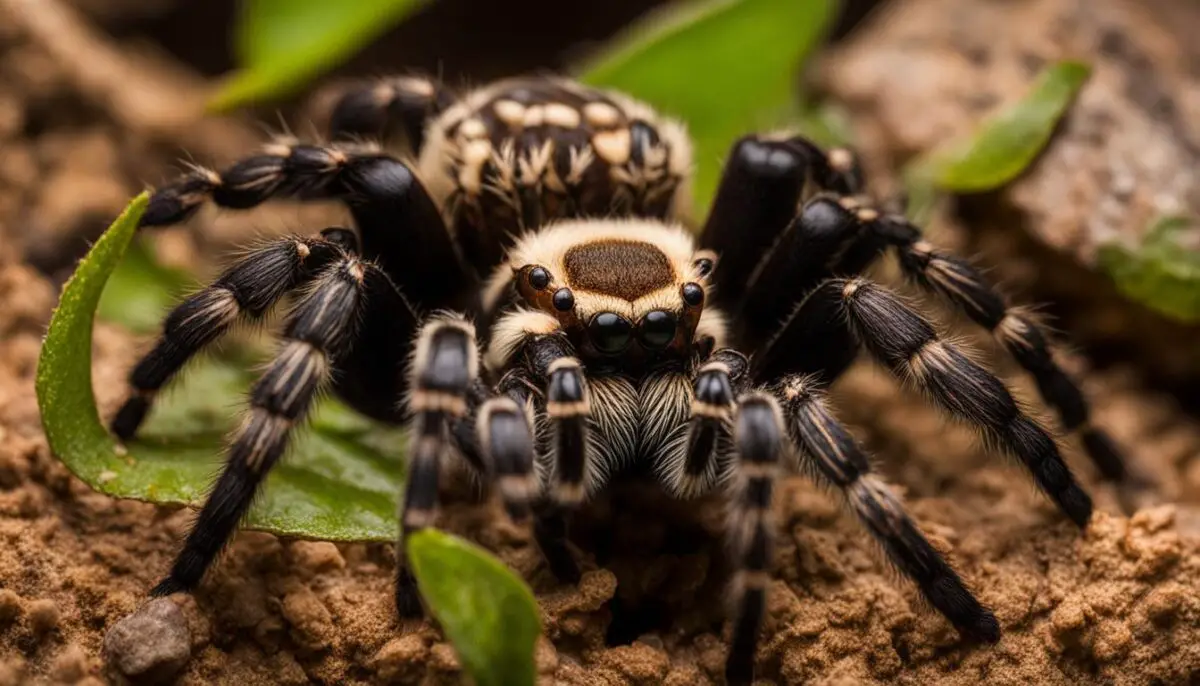
Summary
Researching your tarantula species is essential for providing it with a suitable habitat. By understanding its behavior, natural habitat, and specific requirements, you can create an environment that promotes its natural instincts and overall health. Remember to consider the native range, climate, enclosure size, and setup when designing your tarantula’s habitat.
Enhancing Enrichment Features
While tarantulas are often seen as solitary and sedentary creatures, they can benefit from environmental enrichment. Providing opportunities for natural behaviors and mental stimulation can greatly enhance their well-being. Here are some ways to promote tarantula enrichment:
- Create an obstacle course within the enclosure to encourage exploration and exercise. Use rocks, branches, and other objects to create a challenging path for the tarantula to navigate.
- Offer a variety of hiding spots and webbing areas. Tarantulas are skilled web builders, and by providing different materials and structures for them to create their webs, you can encourage natural behaviors.
- Make environmental changes periodically to mimic the tarantula’s natural habitat. This can include altering the placement of furnishings, introducing new objects or plants, and adjusting the temperature and humidity levels to simulate seasonal changes.
- Rotate feeding spots within the enclosure to encourage foraging behaviors. By placing food in different locations, you can stimulate the tarantula’s natural instinct to search for prey.
Remember, it’s important to observe your tarantula’s behavior and adjust enrichment features accordingly. Every tarantula is unique, and what may be stimulating for one individual may not be as engaging for another. Providing a variety of enrichment options will ensure a well-rounded and fulfilling environment for your tarantula.
Expert Tip:
“Enrichment is a crucial aspect of tarantula care. By offering opportunities for natural behaviors, we can provide a more stimulating and fulfilling environment for these fascinating creatures.” – Dr. Arachnophile, tarantula expert
With careful attention to enrichment, you can promote natural behaviors in your tarantulas and provide an engaging and enriching environment. Remember to continually assess and modify the enrichment features to keep your tarantula’s habitat fresh and stimulating.
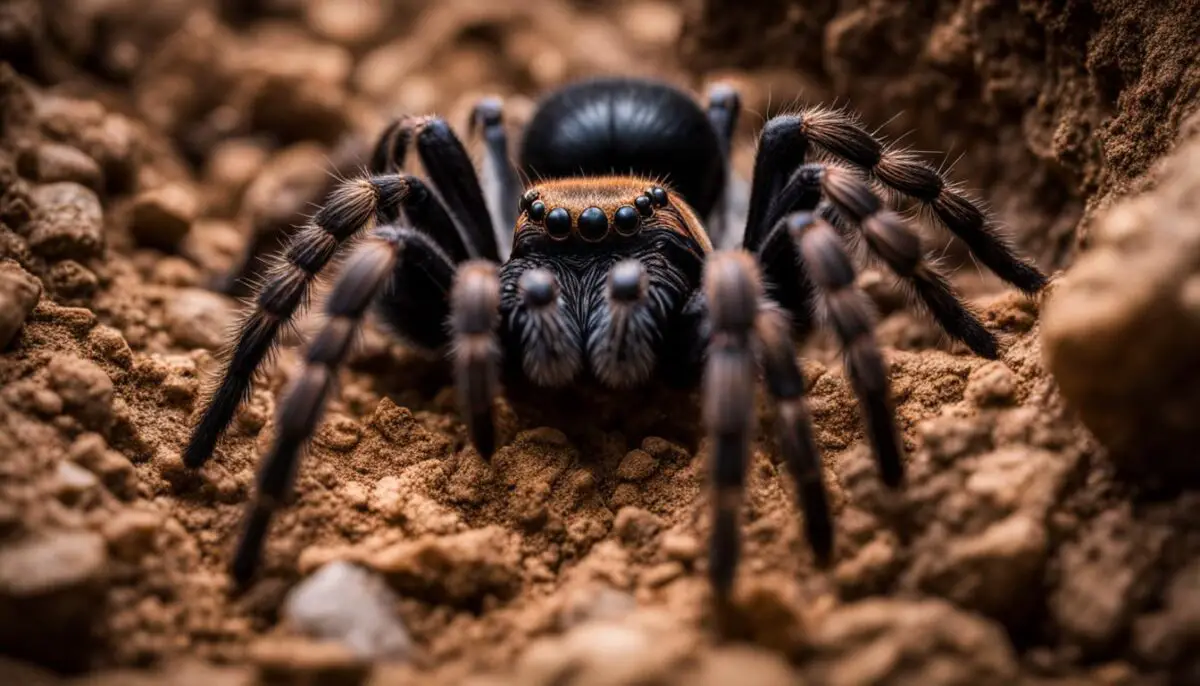
Frequent Questions:
To further enhance tarantula enrichment, many keepers wonder about the use of live prey, the importance of environmental changes, and alternative forms of enrichment. Here are some frequently asked questions:
| Question | Answer |
|---|---|
| Can I use live prey to stimulate hunting behavior? | Yes, offering live prey such as crickets or roaches can encourage natural hunting behaviors in tarantulas. However, it’s essential to ensure the prey is an appropriate size and free of pesticides. |
| How often should I make environmental changes? | Environmental changes can be made every few months to simulate seasonal variations. However, observe your tarantula’s response to the changes and adjust accordingly. |
| Are there alternative forms of enrichment for tarantulas? | Yes, there are various forms of enrichment you can explore, such as providing burrowing substrates, introducing scent trails, or creating climbing challenges. Tailor the enrichment to your tarantula’s species and preferences. |
DIY Naturalistic Enclosures
Creating a slice of the wild for tarantulas in the form of a naturalistic enclosure can be a fulfilling project for experienced keepers. By replicating a tarantula’s natural habitat, you can provide them with a stimulating and enriching environment. To begin, thorough research on your tarantula species is crucial. Understand their native range, burrowing tendencies, and climbing habits to ensure you create an enclosure that closely mimics their natural environment.
When designing a naturalistic enclosure, selecting the appropriate substrate is key. Choose a substrate such as coconut coir that resembles the tarantula’s natural habitat, allowing them to engage in their burrowing behavior. Additionally, introducing live plants can further enhance the enclosure’s realism and provide additional hiding spots for the tarantula.
Designing landscapes within the enclosure can create a visually appealing and diverse habitat. Incorporate rocks, branches, and other natural materials to create climbing structures and obstacles for the tarantula to explore. By offering opportunities for vertical movement and natural behaviors, you can ensure the tarantula’s physical and mental well-being.

Table: Comparison of Naturalistic Enclosure Elements
| Enclosure Element | Advantages | Considerations |
|---|---|---|
| Coconut Coir Substrate | – Mimics tarantula’s natural habitat – Allows for burrowing behavior |
– Requires regular moisture monitoring – May need occasional replacement |
| Live Plants | – Enhances enclosure’s realism – Provides additional hiding spots |
– Requires proper lighting and care – May attract unwanted pests |
| Natural Climbing Structures | – Promotes natural behaviors – Provides physical stimulation |
– Must be securely anchored – Regular inspection for safety |
Creating a naturalistic enclosure is not only aesthetically pleasing but also beneficial for the tarantula’s overall well-being. By replicating their natural habitat, you can offer them a slice of the wild right in your own home.
Continuous observation and adjustment are necessary to ensure the naturalistic enclosure meets the tarantula’s needs. Monitor temperature and humidity levels, provide a suitable diet, and regularly assess the condition of the enclosure. By maintaining a naturalistic environment, you can provide your tarantula with a stimulating and enriching home that closely resembles their native habitat.
Conclusion
In conclusion, providing a suitable habitat for a burrowing tarantula is crucial for its overall well-being and care. By following the steps outlined in this guide, you can ensure that your tarantula’s needs are met and create a safe and comfortable underground home.
Researching your specific tarantula species is essential, as each species has unique burrowing tendencies and habitat requirements. Understanding their natural environment will help you replicate it effectively in captivity.
Remember to consider important factors such as choosing the right enclosure, selecting appropriate substrate, maintaining proper temperature and humidity levels, and providing enriching features like hiding spots and climbing structures. These elements will help simulate the tarantula’s natural behaviors and promote its overall health and happiness.
By following these guidelines and continuously monitoring and adjusting the habitat as needed, you can ensure that your burrowing tarantula thrives in its underground world. Enjoy the rewarding experience of observing these fascinating creatures in their natural habitats!
FAQ
What kind of enclosure should I choose for a burrowing tarantula?
When choosing an enclosure for a burrowing tarantula, it’s important to consider the size of the enclosure to allow for normal burrowing behaviors, the location to minimize stress, and the type of lid to prevent escape.
What type of substrate should I use for a burrowing tarantula?
Coconut coir is an ideal choice for substrate as it is soft and absorbent, mimicking the tarantula’s natural environment. Adding rocks to the enclosure can provide climbing opportunities and ensure the tarantula’s safety.
How do I maintain the correct temperature and humidity levels for a burrowing tarantula?
The recommended temperature range is between 70°F and 85°F. Various heating methods can be used to achieve optimal temperature control, and monitoring with a thermometer is essential. Maintaining appropriate humidity levels is also important for the tarantula’s comfort and health.
What kind of furnishings should I add to a burrowing tarantula’s enclosure?
It’s important to provide hiding areas, such as flower pots or reptile caves, to give the tarantula a sense of security. Adding climbing structures, like branches and vines, can promote natural behaviors and provide vertical climbing opportunities.
What should I feed a burrowing tarantula?
Live insects, such as crickets, grasshoppers, mealworms, and roaches, should be provided as food. Gut loading the insects with nutritious foods and dusting them with supplements will support the tarantula’s growth. Additionally, a shallow dish of fresh water should always be available for the tarantula to drink from.
How often should I clean and maintain the burrowing tarantula’s habitat?
Spot cleaning to remove feces and uneaten food should be done daily. Substrate should be replaced every few months, and the enclosure should be disinfected to prevent bacterial buildup.
How can I research and understand my specific tarantula species?
Researching the native range, burrowing tendencies, and climbing habits of your specific tarantula species is essential to creating an optimal habitat that closely mimics their natural environment.
How can I promote natural behaviors in my burrowing tarantula?
Creating obstacle courses, providing hiding and webbing spots, making environmental changes, and rotating feeding spots can all promote natural behaviors and keep the tarantula mentally stimulated.
How can I create a naturalistic enclosure for my burrowing tarantula?
Thorough research, selecting appropriate substrate, introducing live plants, and designing landscapes are important steps in creating a naturalistic habitat for your tarantula. Continuous observation and adjustment will ensure the tarantula thrives in its naturalistic environment.
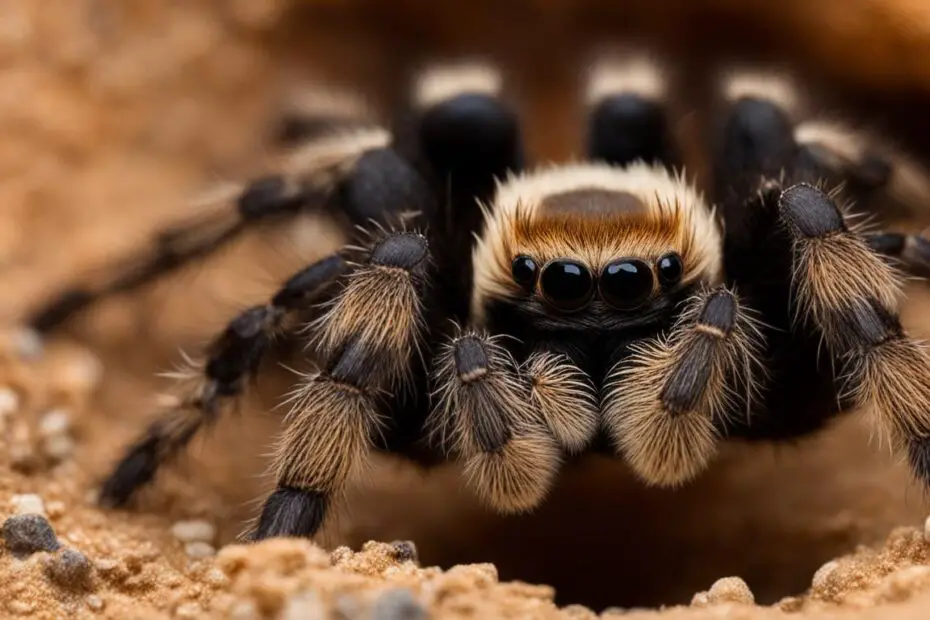

Thanks for one’s marvelous posting! I definitely enjoyed reading it, you are a great author.I will remember to bookmark your blog and will often come back someday. I want to encourage yourself to continue your great writing, have a nice afternoon!
I was examining some of your articles on this website and I think this internet site is really
instructive! Retain posting.Raise blog range